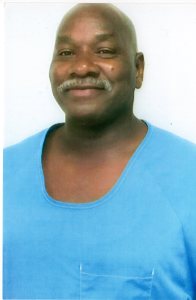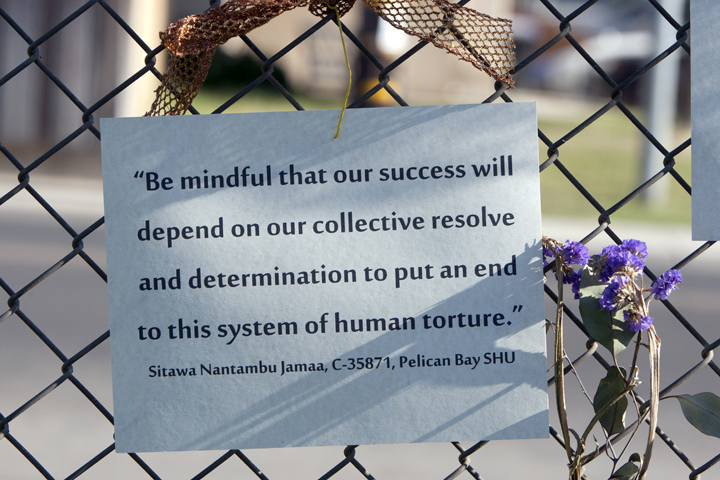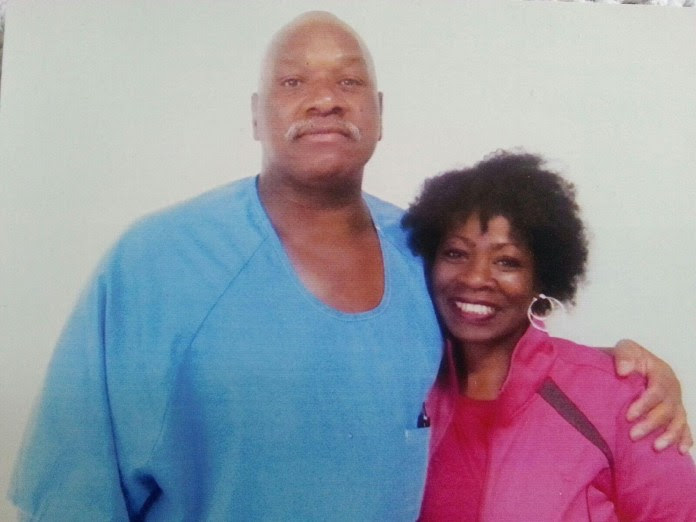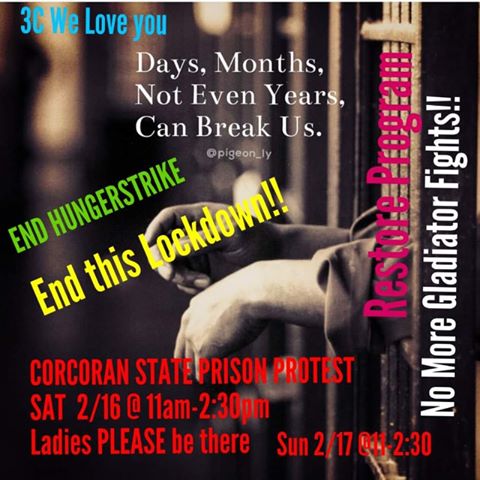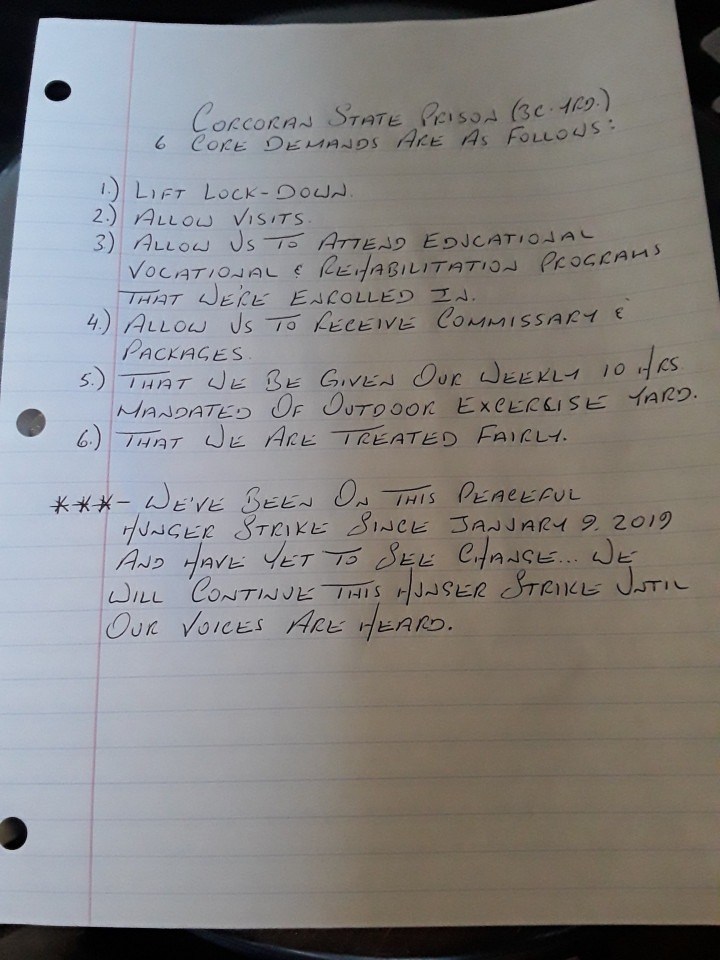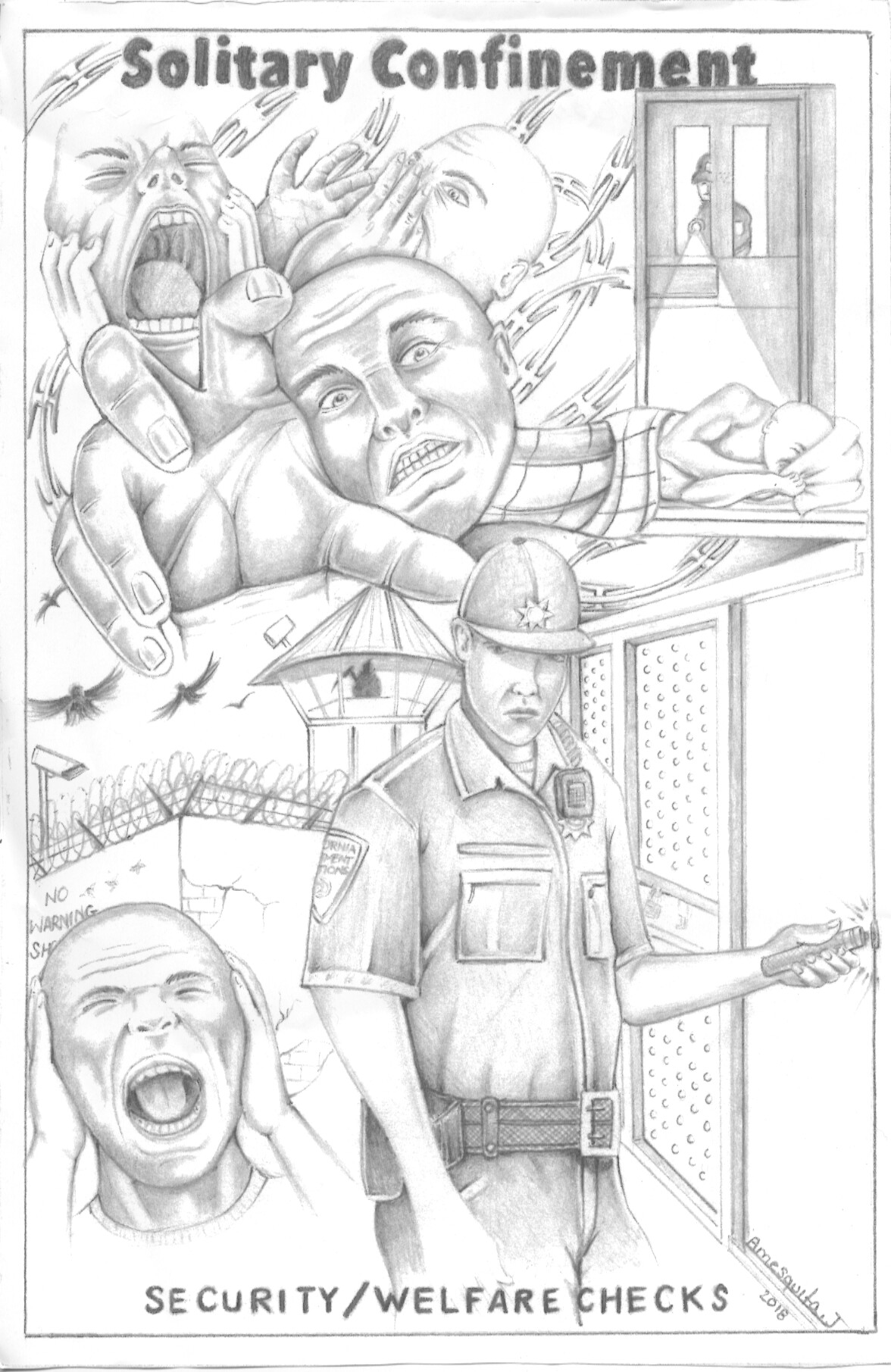Download and/or print all documents in this post as a pdf HERE

These men, known as the “four prisoner Reps,” Todd Ashker, Arturo Castellanos, George Franco and Sitawa Nantambu Jamaa, conceived, planned and led the historic 2011-2013 California mass hunger strikes that drew 30,000 participants at their peak, according to CDCr’s own records.
Introduction from the Prisoner Hunger Strike Solidarity Coalition
What follows below is an update from the leadership of the 2011 and 2013 California Prison Hunger Strikes against indefinite solitary confinement and other mistreatment across the California Department of Corrections and Rehabilitation (CDCr), the world’s largest prison system. These “Reps” had been in solitary for decades and sought to draw attention to and challenge the systematic torture by CDCr through a series of non-violent hunger strikes, two in 2011, and a third in 2013.
In May of 2012, the Center for Constitutional Rights and several prominent prisoner rights attorneys and organizations in California formed a team and partnered with a representative group of 10 Pelican Bay SHU prisoner plaintiffs, including some of the hunger strike reps, to file a class action lawsuit. That lawsuit, Ashker v. Governor of CA, charged that California’s practice of isolating prisoners in solitary confinement for many years, and indefinitely, violated U.S. Constitution protections against “cruel and unusual punishment” and denied Constitutional guarantees to “due process.” Also in 2012, the four Reps and 12 other SHU Prisoner Representatives issued an historic document, the Agreement to End Hostilities, calling for an end to all violence and hostility between different groups of prisoners throughout California.
A third hunger strike began July 8, 2013, involved over 30,000 people incarcerated in California prisons, lasted 60 days, and made solitary confinement a significant issue across the United States. All major U.S. newspapers’ editorial pages had at least one condemnation of the practice in the weeks that followed. The third strike ended when the CA State Senate and State Assembly Committees overseeing prisons held unprecedented public hearings to investigate California’s solitary confinement. On Sept 1, 2015, a landmark settlement was achieved in Ashker v. Governor of CA ending indeterminate solitary confinement in California prisons and allowing the legal team to monitor the California prison system to ensure settlement compliance. This month, February 2020, the four Reps have issued a solidarity statement and California prison update.
SOLIDARITY MESSAGE FROM THE FOUR PRISONER REPS
AND CALIFORNIA PRISON UPDATE
(names listed in alphabetical order)
by Todd Ashker, Arturo Castellanos, George Franco, and Sitawa Nantambu Jamaa
A shout out of solidarity and respect to all class members and prisoners across the state. As the four reps, we felt a public report on the current state of California prisons from prisoners was overdue.
As leadership of the 2011 and 2013 California Prison Hunger Strikes that captured the attention of the nation and the world on the role of solitary confinement in United States prison systems, particularly California, we four prisoner reps became recognized as speaking both for the Ashker class, former Pelican Bay SHU prisoners, but also more broadly in many respects for the entire California prisoner class.
California’s prison system, the largest in the world at that time, was also the greatest abuser of long term solitary confinement. We were housed in the Short Corridor of the notorious Pelican Bay Super Max SHU (Security Housing Unit) and, as all Short Corridor prisoners understood, the only way out of that isolating torturous hell was to “parole, snitch or die.”
We decided standing up together, asserting our humanity even at the cost of our own lives, was better than rotting and dying alone in our concrete tombs. Nonviolent united action was the only path that made sense; our only avenue to act was a hunger strike. It took widespread unity, preparation and work among us prisoners, but also work on the outside by our families, friends and a growing list of supporters across the state and the country.
Without prisoners speaking about our conditions of confinement, the public narrative about imprisonment and mass incarceration is missing a critical voice – our voice, the incarcerated. We are the first-hand experts on the daily experience of being caged in prison generally and the trauma of extreme isolation.
All other experts collect data, do studies, view our experience without living it. Many, not all, are our oppressors. Their expertise is not about what incarceration is like, but why we and so many millions of people in the U.S. should be imprisoned. No voice has more expertise about the experience and impact of incarceration than the voice of prisoners.
Here we make five points:
First. Prison in the United States is based on punishment, not rehabilitation. The United States has the largest prison population in the world and the highest percentage of a state’s population housed in cages. We are held in punishing ways that cause fear, emptiness, rage, depression and violence. Many of us are more damaged when we leave prison than when we entered.
According to the National Reentry Resource Center, a high percentage of state and federal prisoners will be released back into society. National statistics indicate that there is a high rate of released prisoners returning to prison. All of those who leave are older, some smarter, but all of us are less able to be productive in the society at large or good for our communities or our families. It is very hard for former prisoners to get jobs.
Prison presents an opportunity for society to rehabilitate or help people. Many of us could use support services. That opportunity is lost and buried by a vindictive ideology of punishment.
Rather than us being hypervigilant, concentrating on violence, dangers, our fears and rage, prison could be a place to engage our minds in useful jobs and job training, with classrooms for general learning, training in self-awareness and understanding, anti-addiction approaches. Instead, we are mostly just warehoused, sometimes in dangerous yards with angry, frightened, vicious guards.
California’s Governor Newsom has the opportunity to help institute a massive prison reform movement.
Second. California likes to think of itself as a progressive national leader, yet in sentencing California is among the harshest in the nation. In California, a life term is given for second degree murder. Second degree murder is a non-premeditated killing. Only 17 states are that punishing. Two thirds of the states and the U.S. federal system give a flat 15 years.
The U.S. Supreme Court has said that evolving standards of society’s decency should create a national consensus on sentencing standards. Our prison journeys begin in those courts. We four reps of the California prison class call for reform in sentencing. Massive money could be spent for education, training and jobs here and in our communities rather than on caging human beings to harm rather than help us or society.
Third. The trauma we experience in these overcrowded institutions with a culture of aggressive oppression, as if we are violent animals, is harmful and breeds violence. We prisoners should not join in our own oppression. It is not in the interest of the prison class to buy into promised rewards for lying on other prisoners.
The use of lying confidential informants is widespread and legendary in California prisons and jails. We see even among ourselves, who have great active lawyers ready to pay attention to our situations, just how regularly vicious retaliation, evil lying and disregard of our medical needs occurs. Broadly among the California prisoner class, there is mistreatment, horrid isolation, medical disregard, terrible food, cells that are too cold, too hot or too damp.
The history of positive social change demonstrates that when those who are oppressed stand together – as a group, a class – against that oppression, change can happen. Our own experience with eliminating endless solitary confinement in California proves that.
We need to stand with each other, behaving respectfully, demanding respect and not turning on our fellow prisoners for promises of crumbs. We four reps stand for major prison reform that helps us, not harms us, that betters society, not makes it worse.
Fourth. We four reps are for the principles we outlined in the Agreement to End Hostilities, the cessation of all hostilities between groups. We called on prisoners throughout the state to set aside their differences and use diplomatic means to settle their disputes.
If personal issues arise between individuals, people need to do all they can to exhaust all diplomatic means to settle such disputes; do not allow personal, individual issues to escalate into racial group issues. We encourage all prisoners to study the Agreement to End Hostilities and to try to live by those principles to seek your support to strive together for a safer prison environment.
We are not there yet. Dangerous cross-group hostility remains. What we experience in California prisons is not just developed in prison but is also widespread and supported in free society. Racial antagonisms, ghettoized housing, separation, institutionalized racism and promotion of beliefs of each other as less than human, as stupid, as criminal barbarians can cause us to fear and hate each other.It does not serve us or society well. There are no easy ways to challenge these deep American divisions; forcing us together in joint yards, visiting rooms or classrooms will lead to violence and deepen the danger.
We four reps especially call out and stand against 50/50 yards. We oppose forced mixing of hostile groups where mortal enemies are forced together; 50/50 yards are dangerous and will make things much worse by causing fresh horrific encounters. No matter the policy’s intention, the state is responsible for our safety and wellbeing while we’re living under its jurisdiction.
We are entitled to respect and safety. We seek what we are entitled to. The 50/50 yards as a CDCr policy provokes violence. At this time, we endorse separate yards, separate programming and separate visiting.
We also call on California leadership, Governor Newsom and the State Assembly and Senate to implement policies that encourage and grow support for the Agreement to End Hostilities that do not include 50/50 yards or forced interaction, but rather engage our minds and energy with productive jobs, education, training – major prison reform to a genuine rehabilitative system.
Fifth. The guard culture, especially in the yards, is vicious and provocative. Here where we live, the guards do not care about our safety. The guards get extra pay when there is violence; it is in their financial interest to promote it. Not surprisingly, guards regularly provoke disputes. Many enjoy the resulting violence.
California Correctional Peace Officers Association (CCPOA), the powerful guards’ union, is led by men who for the most part consider prisoners less than human. The CCPOA by their network and behavior supports the use of set ups, targeting, lying and isolation for random punishment. This intentionally causes widespread fear.
The CCPOA is one of the most politically influential organizations in California and holds many righteous political leaders hostage. The CCPOA members benefit with large overtime pay bonuses from violence and lockdowns.
Only if prison reform becomes a widespread demand of California voters can the influence of CCPOA be challenged. We need our families, friends and communities to build and extend our allies and develop strong support to vote for politicians who recognize our worth and are for widespread serious prison reform and an end to brutal warehousing that endangers society every day.
CDCR and California itself are legally responsible and accountable for prison conditions. Neglect does not free them of state institution responsibility for those in their “care.” The guards’ union should not be permitted to purchase power for abuse.
California citizens need to vote for prison rehabilitation as a priority: money for teachers, instructors, prisoner jobs instead of lockdown overtime and more guards.
Finally, we close with an update on our legal challenge. Our class action constitutional challenge to long-term solitary confinement was filed in May of 2012. We won a landmark settlement on Sept. 1, 2015, that resulted in thousands of people being released from SHUs across the state.
The settlement also gave us and our legal team the right and responsibility to monitor whether CDCr is following the requirements of the settlement for two years. That monitoring period was set to end in 2017, but in January 2019, U.S. Magistrate Judge Illman granted our motion to extend monitoring of the settlement agreement based on ongoing systemic constitutional violations in CDCR’s use of confidential information and in its reliance on past gang validations to deny parole.
Magistrate Judge Illman’s order extended our monitoring for 12 months. CDCr appealed and asked the court to suspend monitoring pending the appeal outcome. U.S. District Court Judge Wilken intervened and allowed us to continue monitoring pending any appeal outcomes.
Our legal team has two pending appeals that CDCr has filed seeking to overturn the lower court orders in our favor. One appeal covers the extension of the monitoring as discussed above; the other covers enforcement of the settlement agreement regarding conditions of confinement in Level IV prisons and the RCGP (Restricted Custody General Population) unit.
As our legal team continues to monitor implementation of our settlement agreement, they are looking closely at how CDCR uses confidential information to place and keep validated and nonvalidated prisoners in Ad Seg (Administrative Segregation) and RCGP for long periods of time and sentence people to SHU for bogus RVRs (Rules Violation Reports). They are also trying to keep track of how validations continue to impact us, especially when we go before the parole board.
If you have any information about any of these issues, although they cannot respond to every letter, please write our team at: Anne Cappella, Attorney at Law, Weil, Gotshal & Manges, 201 Redwood Shores Pkwy, Fourth Floor, Redwood City, CA 94065.
In closing, we remind all of us prisoners and supporters that we are human beings who have a difficult shared experience. We have a right to our dignity, even inside these punishing walls. We present an opportunity to make society better rather than meaner.
We ask all prisoners to stand together, read and act within the principles of the Agreement to End Hostilities, whether you are in Ad Seg or RCGP or General Population, see yourselves as part of an international Prisoner Human Rights Movement.
We four prisoner reps send regards and recognition to each of you as fellow human beings who are entitled to fairness, dignity and respect. We send our respect to all our brothers and sisters incarcerated anywhere with hopes for genuine rehabilitative programming, jobs, education and training in this coming year.
We send our greetings to all the friends, family and communities from which we come, to all our allies in the general society, and we send our hopes for an understanding of the opportunity California has to again be a leader in reform to make the world a better place with so many of us who need help gathered together in state institutions.
We send extra love, support and attention to our Brother Sitawa Nantambu Jamaa, who is experiencing challenging health issues. Our Brother Sitawa sends his extra love to all those prisoners, prisoners’ families and general supporters of the International Prisoner Human Rights Movement.
February 2020
The authors requested this message be followed with the Agreement to End Hostilities.
AGREEMENT TO END HOSTILITIES
August 12, 2012
To whom it may concern and all California Prisoners:
Greetings from the entire PBSP-SHU Short Corridor Hunger Strike Representatives. We are hereby presenting this mutual agreement on behalf of all racial groups here in the PBSP-SHU Corridor. Wherein, we have arrived at a mutual agreement concerning the following points:
1. If we really want to bring about substantive meaningful changes to the CDCR system in a manner beneficial to all solid individuals, who have never been broken by CDCR’s torture tactics intended to coerce one to become a state informant via debriefing, that now is the time to for us to collectively seize this moment in time, and put an end to more than 20-30 years of hostilities between our racial groups.
Continue reading →


